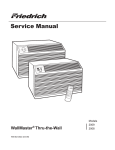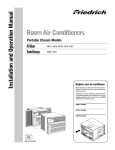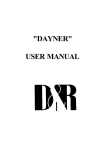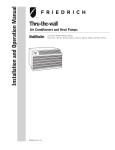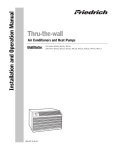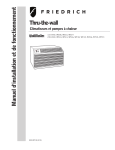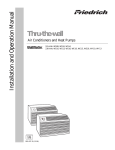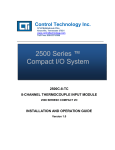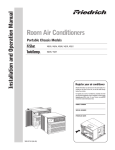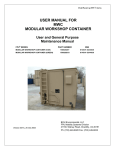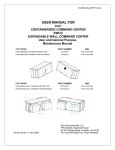Download Friedrich WS16B30A-C Air Conditioner User Manual
Transcript
Service & Parts Manual WallMaster ® Thru-the-Wall WS08B10A-C WS10B10A-C WS14B10A-C PM WS10B30A-C 72 Power Cool Fan Speed Mode ® Money Saver Fan Only Clock On/Off Timer Hour Set Start Time Stop Time Temp/Hour WS13B30B-C WS16B30A-C WE10B33A-B WE13B33B-B WE16B33A-B WY10B33A-B WY13B33A-B WM-Svc-Prts-07 (3-07) TABLE OF CONTENTS Warranty .....................................................................................................................................................3 Routine Maintenance ................................................................................................................................4 Unit Identification ......................................................................................................................................5 Performance Data .....................................................................................................................................6 Electrical Data ...........................................................................................................................................7 Functional Component Definitions .........................................................................................................8 Electronic Controls ...................................................................................................................................9 Rotary Controls .......................................................................................................................................10 Refrigeration Sequence of Operation ...................................................................................................11 Sealed Refrigeration Repairs ........................................................................................................... 12-13 Refrigerant Charging ..............................................................................................................................13 General Troubleshooting.................................................................................................................. 14-20 Wiring Diagrams ................................................................................................................................ 21-25 Parts Diagram ..........................................................................................................................................26 Parts Lists .......................................................................................................................................... 27-29 2 Friedrich Air Conditioning Company P.O. Box 1540 San Antonio, TX 78295 210.357.4400 www.friedrich.com WALLMASTER£ THRU-THE-WALL AIR CONDITIONERS LIMITED WARRANTY FIRST YEAR ANY PART: If any part supplied by FRIEDRICH fails because of a defect in workmanship or material within twelve months from date of original purchase, FRIEDRICH will repair the product at no charge, provided room air conditioner is reasonably accessible for service. Any additional labor cost for removing inaccessible units and/or charges for mileage related to travel by a Service Agency that exceeds 25 miles one way will be the responsibility of the owner. This remedy is expressly agreed to be the exclusive remedy within twelve months from the date of the original purchase. SECOND THROUGH FIFTH YEAR SEALED REFRIGERANT SYSTEM: If the Sealed Refrigeration System (defined for this purpose as the compressor, condenser coil, evaporator coil, reversing valve, check valve, capillary, filter drier, and all interconnecting tubing) supplied by FRIEDRICH in your Room Air Conditioner fails because of a defect in workmanship or material within sixty months from date of purchase, FRIEDRICH will pay a labor allowance and parts necessary to repair the Sealed Refrigeration System; PROVIDED FRIEDRICH will not pay the cost of diagnosis of the problem, removal, freight charges, and transportation of the air conditioner to and from the Service Agency, and the reinstallation charges associated with repair of the Sealed Refrigeration System. All such cost will be the sole responsibility of the owner. This remedy is expressly agreed to be the exclusive remedy within sixty months from the date of the original purchase. APPLICABILITY AND LIMITATIONS: This warranty is applicable only to units retained within the Fifty States of the U.S.A., District of Columbia, and Canada. This warranty is not applicable to: 1. 2. 3. Air filters or fuses. Products on which the model and serial numbers have been removed. Products which have defects or damage which results from improper installation, wiring, electrical current characteristics, or maintenance; or caused by accident, misuse or abuse, fire, flood, alterations and/or misapplication of the product and/or units installed in a corrosive atmosphere, default or delay in performance caused by war, government restrictions or restraints, strikes, material shortages beyond the control of FRIEDRICH, or acts of God. OBTAINING WARRANTY PERFORMANCE: Service will be provided by the FRIEDRICH Authorized Dealer or Service Organization in your area. They are listed in the Yellow Pages. If assistance is required in obtaining warranty performance, write to: Room Air Conditioner Service Manager, Friedrich Air Conditioning Co., P.O. Box 1540, San Antonio, TX 78295-1540. LIMITATIONS: THIS WARRANTY IS GIVEN IN LIEU OF ALL OTHER WARRANTIES. Anything in the warranty notwithstanding, ANY IMPLIED WARRANTIES OF FITNESS FOR PARTICULAR PURPOSE AND/OR MERCHANTABILITY SHALL BE LIMITED TO THE DURATION OF THIS EXPRESS WARRANTY. MANUFACTURER EXPRESSLY DISCLAIMS AND EXCLUDES ANY LIABILITY FOR CONSEQUENTIAL OR INCIDENTAL DAMAGE FOR BREACH OF ANY EXPRESSED OR IMPLIED WARRANTY. NOTE: Some states do not allow limitations on how long an implied warranty lasts, or do not allow the limitation or exclusion of consequential or incidental damages, so the foregoing exclusions and limitations may not apply to you. OTHER: This warranty gives you specific legal rights, and you may also have other rights which vary from state to state. PROOF OF PURCHASE: Owner must provide proof of purchase in order to receive any warranty related services. All service calls for explaining the operation of this product will be the sole responsibility of the consumer. All warranty service must be provided by an Authorized FRIEDRICH Service Agency, unless authorized by FRIEDRICH prior to repairs being made. (10-04) 3 ROUTINE MAINTENANCE NOTE: Units are to be inspected and serviced by qualified service personnel only. Routine maintenance is required annually or semi-annually, depending upon annual usage. 1. Clean the unit air intake filter at least every 250 to 300 fan hours of operation or when the unit’s indicator light is on if so equipped. Clean the filters with a mild detergent in warm water and allow to dry thoroughly before reinstalling. 2. The indoor coil (evaporator coil), the outdoor coil (condenser coil) and base pan should be inspected periodically (yearly or bi-yearly) and cleaned of all debris (lint, dirt, leaves, paper, etc.). Clean the coils and base pan with a soft brush and compressed air or vacuum. If using a pressure washer, be careful not to bend the aluminium fin pack. Use a sweeping up and down motion in the direction of the vertical aluminum fin pack when pressure cleaning coils. Cover all electrical components to protect them from water or spray. Allow the unit to dry thoroughly before reinstalling it in the sleeve. NOTE: Do not use a caustic coil cleaning agent on coils or base pan. Use a biodegradable cleaning agent and degreaser. Inspect the indoor blower housing, evaporator blade, condenser fan blade, and condenser shroud periodically (yearly or bi-yearly) and clean of all debris (lint, dirt, mold, fungus, etc.) Clean the blower housing area and blower wheel with an antibacterial / antifungal cleaner. Use a biodegradable cleaning agent and degreaser on condenser fan and condenser shroud. Use warm or cold water when rinsing these items. Allow all items to dry thoroughly before reinstalling them. 3. Periodically (at least yearly or bi-yearly): inspect all control components, both electrical and mechanical, as well as the power supply. Use proper testing instruments (voltmeter, ohmmeter, ammeter, wattmeter, etc.) to perform electrical tests. Use an air conditioning or refrigeration thermometer to check room, outdoor and coil operating temperatures. Use a sling psychrometer to measure wet bulb temperatures indoors and outdoors. 4. Inspect the surrounding area (inside and outside) to ensure that the units’ clearances have not been compromised or altered. 5. Inspect the sleeve and drain system periodically (at least yearly or bi-yearly) and clean of all obstructions and debris. Clean both areas with an antibacterial and antifungal cleaner. Rinse both items thoroughly with water and ensure that the drain outlets are operating correctly. Check the sealant around the sleeve and reseal areas as needed. 6. Clean the front cover when needed. Use a mild detergent. Wash and rinse with warm water. Allow it to dry thoroughly before reinstalling it in the chassis. 4 FRIEDRICH ROOM MODEL NUMBER CODE W S 08 B 1 0 B 1st DIGIT - FUNCTION W = Thru-The-Wall, WallMaster Series 2nd DIGIT - TYPE S = Straight Cool E = Electric Heat Y = Heat Pump 3rd & 4th DIGITS - APPROXIMATE BTU/HR (Cooling) Heating BTU/HR capacity listed in Specifications/Performance Data Section 5th DIGIT - ALPHABETICAL MODIFIER 6th DIGIT - VOLTAGE 1 = 115 Volts 3 = 230-208 Volts 7th DIGIT 0 = Straight Cool & Heat Pump Models ELECTRIC HEAT MODELS 3 = 3 KW Heat Strip, Nominal 8th DIGIT Major Change RAC SERIAL NUMBER IDENTIFICATION GUIDE Serial Number Decade Manufactured L=0 C=3 F=6 A=1 D=4 G=7 B=2 E=5 H=8 Year Manufactured A=1 D=4 G=7 L J=9 K=0 C G R 00001 Production Run Number Product Line R = RAC B=2 E=5 H=8 P = PTAC C=3 F=6 J=9 E = EAC Month Manufactured A=Jan D=Apr G=Jul B=Feb V = VPAK K=Oct H = Split E=May H=Aug L=Nov C=Mar F=Jun J=Sept M=Dec 5 6 Cooling Capacity BTU/h 8000 10000 13500 10000/10000 12500/12000 15800/15000 10000/10000 12500/12000 15800/15000 10100/9800 12500/12100 Model # WS08B10A WS10B10A WS14B10A WS10B30A WS13B30B WS16B30A WE10B33A WE13B33B WE16B33A WY10B33A WY13B33A 25 28 28 25 29 28 27 29 28 27 29 — — — — — — 11000/9100 11000/9100 11000/9100 8100/7800 10400/10000 Heating Capacity BTU/h 55 53 52 53 52 51 54 52 51 54 52 E(in) 125V - 15A 250V - 15A 250V - 20A WS08B10A, WS10B10A, WS14B10A WS10B30A, WS13B30A, WS16B30A WE10, WE13, WE16 WY10, WY13 Model Numbers Circuit Rating Breaker or T-D Fuse 55 51 52 57 50 53 52 51 53 52 51 6 - 20P 6 - 15P 5 - 15P Plug Face (NEMA#) 115 115 115 230/208 230/208 230/208 230/208 230/208 230/208 230/208 230/208 Volts Rated 127 128 128 131 128 121 126 127 121 126 127 61 68 63 68 57 54 82 64 57 66 64 Suction Temp Wall Outlet Appearance 6.8 8.7 12.0 4.6/5.0 6.3/6.7 7.8/8.5 4.6/5.0 6.3/6.7 7.8/8.5 4.6/4.8 6.4/6.8 Cooling Amps 165 176 179 179 174 154 180 180 174 180 180 CONDENSER TEMP. Discharge E (out) DEG. F Temp EVAPORATOR TEMP. DEG. F Installation Information 55 52 52 55 51 52 53 52 52 53 52 WS08B10A WS10B10A WS14B10A WS10B30A WS13B30B WS16B30A WE10B33A WE13B33B WE16B33A WY10B33A WY13B33A Discharge Temp. Air Drop F. EVAPORATOR AIR TEMP. DEG. F 762 954 1415 1005/996 1404/1379 1756/1705 1005/996 1404/1379 1756/1705 1013/976 1389/1352 Cooling Watts 102 105 99 106 100 99 99 103 100 99 103 Liquid Temp 18 16 14 16 13 18 16 13 18 16 16 — — — — — — 3550/2950 3550/2950 3550/2950 857/821 1182/1136 — — — — — — 16.0/14.7 16.0/14.7 16.0/14.7 3.9/4.0 5.4/5.7 281 293 297 289 295 315 289 295 315 225 300 Heating Watts 87 79 82 77 78 74 82 80 74 82 80 Heating Amps 25 24 28 23 30 32 31 29 30 31 29 WSC Sleeve Chassis Model Width 27" 26 1/2" Height 16 3/4" 15 3/4" Depth 16 3/4" 21" 23" – Depth with Front Energy Efficiency Ratio EER 7.1 9.0 12.4 4.6 6.5 7.7 4.6 15.2 6.5 15.7 6.5 16.1 4.6 4 / 15.2 6.5 5.6 / 15.7 10.5 10.5 9.5 10.0/10.0 8.9/8.7 9.0/8.8 10.0/10.0 8.9/8.7 9.0/8.8 10.0/10.0 9.0/9.0 R-22 REF. 7 1/2" – Minimum Extension Into Room 1.3 2.4 3.3 2.1 3.3 4.2 2.1 3.3 4.2 2.5 3.2 Moisture Removal Pints/Hr. 36.2 45.0 58.0 26.0 27.4 35.0 45.0 27.4 35.0 26.0 27.4 257 248 293 235 281 292 225 274 281 225 260 9/16" – Minimum Extension Outside 245 245 295 260 280 290 260 280 290 230 280 Room Side Air Circulation 20.5 22.0 44.9 22.5 35.2 47.6 38.0 35.0 35.2 38.0 35.0 Amps Locked Charge in Evap Heat Rotor Amps OZ. CFM ELECTRICAL RATINGS SubAmps Cooling Suction Discharge Cool Sleeve Dimensions Super Heat OPERATING PRESSURES 15 15 15 15 15 15 20 20 20 20 20 17 1/4" – 27 1/4" – Thru-the-wall Finished Hole Height Width 93 103 112 101 109 119 103 111 121 107 116 Net Weight Lbs. 1100 1100 1300 1100 1300 1421 1074 1318 1305 1074 1200 Motor 60 Hertz RPM Amps BREAKER FUSE PERFORMANCE DATA * Rating Conditions: 80 degrees F, room air temp. & 50% relative humidity, with 95 degree F, outside air temp & 40% relative humidity Calculate the heat loss of the space to be heated. As long as the heat loss does not exceed the resistance heating capacity rating of the unit, the heating performance will be satisfactory. Change-over from heat pump operation to resistance operation on models indicated is automatic at a preset outside ambient temperature of approximately 35°F. If condensate disposal is desired, an optional drain kit is available. DEFROST CONTROL: Initiated at 20°F (outdoor coil temperature) and terminated at 43°F (outdoor coil temperature). During defrost, the compressor stops and the electric heat starts, then operates with the fan to maintain indoor comfort. Below 43°F, the unit remains in electric heat mode. During electric heat mode, the unit will achieve the following ratings: 11000/9100 BTU/h, 16.0/14.7 amps, and 3550/2950 watts. DEFROST DRAIN: Drain automatically opens at approximately 50°F in outdoor base pan for defrost condensate disposal. ELECTRICAL DATA Wire Size Use ONLY wiring size recommended for single outlet branch circuit. Fuse/Circuit Use ONLY type and size fuse or HACR Breaker circuit breaker indicated on unit’s rating plate. Proper current protection to the unit is the responsibility of the owner. Grounding Receptacle Unit MUST be grounded from branch circuit through service cord to unit, or through separate ground wire provided on permanently connected units. Be sure that branch circuit or general purpose outlet is grounded. ELECTRIC SHOCK HAZARD. Turn off electric power before service or installation. All electrical connections and wiring MUST be installed by a qualified electrician and conform to the National Electrical Code and all local codes which have jurisdiction. Failure to do so can result in property damage, personal injury and/or death. The field supplied outlet must match plug on service cord and be within reach of service cord. Do NOT alter the service cord or plug. Do NOT use an extension cord. Refer to the table above for proper receptacle and fuse type. The consumer - through the AHAM Room Air Conditioner Certification Program - can be certain that the AHAM Certification Seal accurately states the unit’s cooling and heating capacity rating, the amperes and the energy efficiency ratio. 7 FUNCTIONAL COMPONENTS A. Mechanical components Bellows condensate valve Temperature-sensitive valve that opens up to drain off condensate water when the outside temperature falls below 40°F and closes when the outside temperature reaches 58°F. Plenum assembly Diffuser with directional louvers used to direct the conditioned airflow. Blower wheel Attaches to the indoor side of the fan motor shaft and is used for distributing unconditioned, room side air though the heat exchanger and delivering conditioned air into the room. Slinger fan blade Attaches to the outdoor side of the fan motor shaft and is used to move outside air through the condenser coil, while slinging condensate water out of the base pan and onto the condenser coil, thus lowering the temperature and pressures within the coil. B. Electrical components Thermostat Used to maintain the specified room side comfort level System switch Used to regulate the operation of the fan motor, the compressor or to turn the unit off. For troubleshooting, refer to the wiring diagrams and schematics in the back of this service manual. Capacitor Reduces line current and steadies the voltage supply, while greatly improving the torque characteristics of the fan motor and compressor motor. MoneySaver® switch When engaged, it sends the power supply to the fan motor through the thermostat, which allows for a cycle-fan operation. Fan Motor Dual-shafted fan motor operates the indoor blower wheel and the condenser fan blade simultaneously. Solenoid Used to energize the reversing valve on all heat pump units. Heating element Electric resistance heater, available in 3.3, 4.0 or 5.2 kW on select TwinTemp® models. Heat anticipator Used to provide better thermostat and room air temperature control. C. Hermetic components Compressor Motorized device used to compress refrigerant through the sealed system. Reversing valve A four-way switching device used on all heat pump models to change the flow of refrigerant to permit heating or cooling. Check valve A pressure-operated device used to direct the flow of refrigerant to the proper capillary tube, during either the heating or cooling cycle. Capillary tube A cylindrical meter device used to evenly distribute the flow of refrigerant to the heat exchangers (coils.) 8 SYSTEM CONTROL PANEL (“WS” Models) Figure 6: System Control Panel Activating Error Code Mode (Submode of Test Mode) Unit must be in Test Mode to enter Error Code Mode 1. PM 72 Power Cool Fan Speed Mode Money Saver® Fan Only Clock Timer On/Off Set Hour Start Time Stop Time Temp/Hour Activate Error Code Mode by pressing the “TIMER ON/OFF” button on XQ & WS models. LED for the “TIMER ON/OFF” will flash 1bps while Error Code Mode is active. Pressing the “TEMP/HR + ” button will display 00. Consecutive presses will scroll through all error codes logged. Press the “TEMP/HR - ” button to see the reverse order of all error codes logged. When the end of logged error codes is reached the temperature set point will appear. IMPORTANT Error Codes are cleared from the log by exiting from Error Code Mode. To exit on XQ & WS models, press Timer On/ Off button. Or unplug unit to exit Error Code Mode. Plug unit in after 5 seconds to resume normal operation of unit. ERROR CODE LISTINGS TESTING THE ELECTRONIC CONTROL CHECKING ROOM TEMPERATURE 1. Check the room temperature at the electronic control pad by pressing at the same time the “FAN SPEED” button and the temperature “UP” button on XQ & WS models. 2. The indoor temperature will display for 10 seconds. Indoor temperature can be viewed in all modes, including the TEST mode. The display can be changed back to SET temperature by pressing any key, except the ON/OFF button, or after 10seconds has elapsed. ACTIVATING TEST MODE Activate test mode by pressing at the same time the “MODE” button and the temperature “DOWN” button on XQ & WS models. LEDs for Hour, Start, and Stop will blink 1bps while Test Mode is active. Test Mode has duration of 90 minutes. Test Mode can be activated under any conditions, including Off. Test Mode is cancelled by pressing the On/Off button, unplugging the unit, or when the 90 minutes is timed out. All settings revert to the factory default settings of Cool, 75 degrees F, Timer and Set Hour features are nonfunctional. Test Mode overrides the three-minute lockout, all delays for compressor and fan motor start / speed change, and no delay when switching modes. E1 SHORT CYCLE SITUATION: Defined as compressor powered on before the three minute time delay ten times in one hour. Investigate and correct short cycling problem. E2 KEYBOARD STUCK ERROR: If key button(s) are pressed continuously for twenty seconds or more. If MODE key is stuck, unit will default to cool. Exit Error Code Mode to see if error “E2” is no longer displayed and unit is functioning. Replace board if “E2” still displays after exiting Error Code Mode. E3 FROST PROBE OPEN: Normal operation is allowed. Ohm frost probe. Replace probe if ohm value not read. If ohm value present replace board. E4 FROST PROBE SHORT: allowed. Replace probe. E5 INDOOR PROBE OPEN: Control assumes indoor ambient temperature is 90 degree F and unit will operate. Ohm indoor probe. Replace probe if ohm value not read. E6 INDOOR PROBE SHORT: Control assumes ambient temperature is 90 degree F and unit will operate. Replace probe. Normal operation NOTE: All Error Code displays for Frost & Indoor Probe will allow unit to operate. Unit may or will ice up if faulty components not replaced. Test Mode default settings are ON, Money Saver, 60 degrees F, and High fan speed. 9 Frost Probe Sensor: Disables compressor at 35 degrees F +/- 3 degrees F Indoor Probe Sensor: Control range is 60 degrees F to 90 degrees F +/- 2 degrees F Indoor temperature will be displayed by pressing: (XQ / WS Units) The Fan Speed button and the Temp Up button. The indoor temperature will be displayed for 10 seconds. The display will change back to the Set Point temperature by pressing any key button except for the On/Off button. The indoor temperature can be viewed in all modes, including test mode. Keep Alive: The electronic control has a memory to retain all functions and status as set up by the user in the event of a power failure. Once power is restored to the unit there is a two second delay before the fan comes on and approximately three minutes delay before the compressor is activated, providing that the mode was set for cooling and the set point temperature has not been met in the room. SYSTEM CONTROL SWITCH (“WE” & “WY” Models) An eight position switch is used to regulate the operation of the fan motor, compressor and electric heater. The unit can be operated in cooling or heating mode with the compressor or electric heater on and the fan motor operating on low, medium or high speed. SYSTEM CONTROL SWITCH - TEST Disconnect leads from control switch. Turn control to position being tested (see Figure 8). There must be continuity as follows: 1. “Off” Position-no continuity between terminals. 2. “Lo Cool” Position-between terminals “C” and “3”, “C2” and “2”, “LO” and “M/S”, “AR” and “5”. 3. “Med Cool” Position-between terminals “C” and “3”, “C2” and “2”, “M” and “M/S”, “AR” and “5”. 4. “Hi Cool” Position-between terminals “C” and “3”, “C2” and “2”, “H” and “M/S”, “AR” and “5”. 5. “Hi Heat” Position-between terminals “C” and “1”, “C2” and “4”, “H” and “M/S”, “AR” and “5”. 6. “Med Heat” Position-between terminals “C” and “1”, “C2” and “4”, “M” and “M/S”, “AR” and “5”. 7. “Lo Cool” Position-between terminals “C” and “1”, “C2” and “4”, “LO” and “M/S”, “AR” and “5”. 8. “Fan Only” Position-between terminals “L1”, “M” and “2”. Figure 8: System Control Switch (Heat Pump & Electric Heat Models) The fan motor can also be operated independently on medium speed. See switch section as indicated on decorative control panel, in Figure 7. Figure 7: System Control Panel Fan Only Low Heat Med Heat High Heat NOTE: Units will operate in constant fan in the cooling mode and auto fan in the heating mode. Off Low Cool Med Cool High Cool ! Allow 3 min. between restarts 10 MAX HEAT MAX COOL REFRIGERATION SYSTEM SEQUENCE OF OPERATION A good understanding of the basic operation of the refrigeration system is essential for the service technician. Without this understanding, accurate troubleshooting of refrigeration system problems will be more difficult and time consuming, if not (in some cases) entirely impossible. The refrigeration system uses four basic principles (laws) in its operation they are as follows: 1. “Heat always flows from a warmer body to a cooler body.” 2. “Heat must be added to or removed from a substance before a change in state can occur” 3. “Flow is always from a higher pressure area to a lower pressure area.” 4. “The temperature at which a liquid or gas changes state is dependent upon the pressure.” The refrigeration cycle begins at the compressor. Starting the compressor creates a low pressure in the suction line which draws refrigerant gas (vapor) into the compressor. The compressor then “compresses” this refrigerant, raising its pressure and its (heat intensity) Temperature. The refrigerant leaves the compressor through the discharge line as a hot high pressure gas (vapor). The refrigerant enters the condenser coil where it gives up some of its heat. The condenser fan moving air across the coil’s finned surface facilitates the transfer of heat from the refrigerant to the relatively cooler outdoor air. When a sufficient quantity of heat has been removed from the refrigerant gas (vapor), the refrigerant will “condense” (i.e. change to a liquid). Once the refrigerant has been condensed (changed) to a liquid it is cooled even further by the air that continues to flow across the condenser coil. The RAC design determines at exactly what point (in the condenser) the change of state (i.e. gas to a liquid) takes place. In all cases, however, the refrigerant must be totally condensed (changed) to a liquid before leaving the condenser coil. The refrigerant leaves the condenser coil through the liquid line as a warm high pressure liquid. It next will pass through the refrigerant drier (if so equipped). It is the function of the drier to trap any moisture present in the system, contaminants, and large particulate matter. The liquid refrigerant next enters the metering device. The metering device is a capillary tube. The purpose of the metering device is to “meter” (i.e. control or measure) the quantity of refrigerant entering the evaporator coil. In the case of the capillary tube this is accomplished (by design) through size (and length) of device, and the pressure difference present across the device. Since the evaporator coil is under a lower pressure (due to the suction created by the compressor) than the liquid line, the liquid refrigerant leaves the metering device entering the evaporator coil. As it enters the evaporator coil, the larger area and lower pressure allows the refrigerant to expand and lower its temperature (heat intensity). This expansion is often referred to as “boiling”. Since the unit’s blower is moving Indoor air across the finned surface of the evaporator coil, the expanding refrigerant absorbs some of that heat. This results in a lowering of the indoor air temperature, hence the “cooling” effect. The expansion and absorbing of heat cause the liquid refrigerant to evaporate (i.e. change to a gas). Once the refrigerant has been evaporated (changed to a gas), it is heated even further by the air that continues to flow across the evaporator coil. The particular system design determines at exactly what point (in the evaporator) the change of state (i.e. liquid to a gas) takes place. In all cases, however, the refrigerant must be totally evaporated (changed) to a gas before leaving the evaporator coil. The low pressure (suction) created by the compressor causes the refrigerant to leave the evaporator through the suction line as a cool low pressure vapor. The refrigerant then returns to the compressor, where the cycle is repeated. Refrigerant System Components Suction Line Discharge Line Evaporator Coil Condenser Coil Compressor Metering Device Refrigerant Drier Liquid Line SEALED REFRIGERATION SYSTEM REPAIRS IMPORTANT ANY SEALED SYSTEM REPAIRS TO COOL-ONLY MODELS REQUIRE THE INSTALLATION OF A LIQUID LINE DRIER. ALSO, ANY SEALED SYSTEM REPAIRS TO HEAT PUMP MODELS REQUIRE THE INSTALLATION OF A SUCTION LINE DRIER. 11 SEALED REFRIGERATION SYSTEM REPAIRS EQUIPMENT REQUIRED: 1. Voltmeter HERMETIC COMPONENT REPLACEMENT The following procedure applies when replacing components in the sealed refrigeration circuit or repairing refrigerant leaks. (Compressor, condenser, evaporator, capillary tube, refrigerant leaks, etc.) 1. Recover the refrigerant from the system at the process tube located on the high side of the system by installing a line tap on the process tube. Apply gauge from process tube to EPA approved gauges from process tube to EPA approved recovery system. Recover CFCs in system to at least 5%. 2. Cut the process tube below pinch off on the suction side of the compressor. 3. Connect the line from the nitrogen tank to the suction process tube. 4. Drift dry nitrogen through the system and unsolder the more distant connection first. (Filter drier, high side process tube, etc.) 5. Replace inoperative component, and always install a new filter drier. Drift dry nitrogen through the system when making these connections. 6. Pressurize system to 30 PSIG with proper refrigerant and boost refrigerant pressure to 150 PSIG with dry nitrogen. 1. Evacuation from both the high side and low side of the system simultaneously. 7. Leak test complete system with electric halogen leak detector, correcting any leaks found. 2. Introducing refrigerant charge into high side of the system. 8. Reduce the system to zero gauge pressure. 9. Connect vacuum pump to high side and low side of system with deep vacuum hoses, or copper tubing. (Do not use regular hoses.) 2. Ammeter 3. Ohmmeter 4. Vacuum Pump (capable of 200 microns or less vacuum.) 5. Acetylene Welder 6. Electronic Halogen Leak Detector (G.E. Type H-6 or equivalent.) 7. Accurate refrigerant charge measuring device such as: a. Balance Scales - 1/2 oz. accuracy b. Charging Board - 1/2 oz. accuracy 8. High Pressure Gauge - (0 - 400 lbs.) 9. Low Pressure Gauge - (30 - 150 lbs.) 10. Vacuum Gauge - (0 - 1000 microns) EQUIPMENT MUST BE CAPABLE OF: 3. Accurately weighing the refrigerant charge actually introduced into the system. 4. Facilities for flowing nitrogen through refrigeration tubing during all brazing processes. 12 10. 11. Evacuate system to maximum absolute holding pressure of 200 microns or less. NOTE: This process can be speeded up by use of heat lamps, or by breaking the vacuum with refrigerant or dry nitrogen at 5,000 microns. Pressure system to 5 PSIG and leave in system a minimum of 10 minutes. Release refrigerant, and proceed with evacuation of a pressure of 200 microns or less. Break vacuum by charging system from the high side with the correct amount of refrigerant specified. This will prevent boiling the oil out of the crankcase. NOTE: If the entire charge will not enter the high side, allow the remainder to enter the low side in small increments while operating the unit. 12. Restart unit several times after allowing pressures to stabilize. Pinch off process tubes, cut and solder the ends. Remove pinch off tool, and leak check the process tube ends. ROTARY COMPRESSOR SPECIAL TROUBLESHOOTING AND SERVICE Basically, troubleshooting and servicing rotary compressors is the same as on the reciprocating compressor with only a few exceptions. 1. Because of the spinning motion of the rotary, the mounts are critical. If vibration is present, check the mounts carefully. 2. The electrical terminals on the rotary are in a different order than the reciprocating compressors. The terminal markings are on the cover gasket. Use your wiring diagram to insure correct connections. REFRIGERANT CHARGE 1. The refrigerant charge is extremely critical. Measure charge carefully - as exact as possible to the nameplate charge. 2. SPECIAL PROCEDURE IN THE CASE OF MOTOR COMPRESSOR BURNOUT 1. Recover all refrigerant and oil from the system. 2. Remove compressor, capillary tube and filter drier from the system. 3. Flush evaporator condenser and all connecting tubing with dry nitrogen or equivalent, to remove all contamination from system. Inspect suction and discharge line for carbon deposits. Remove and clean if necessary. 4. Reassemble the system, including new drier strainer and capillary tube. 5. Proceed with processing as outlined under hermetic component replacement. The correct method for charging the rotary is to introduce liquid refrigerant into the high side of the system with the unit off. Then start compressor and enter the balance of the charge, gas only, into the low side. The introduction of liquid into the low side, without the use of a capillary tube, will cause damage to the discharge valve of the rotary compressor. NOTE: All inoperative compressors returned to Friedrich must have all lines properly plugged with the plugs from the replacement compressor. 13 TROUBLESHOOTING TOUCH TEST CHART: TO SERVICE REVERSING VALVES Tube to OUTSIDE COIL LEFT Pilot Capillary Tube RIGHT Pilot Capillary Tube 1 2 3 4 5 6 Hot as (1) *TVB TVB Cool as (2) *TVB TVB Tube to INSIDE COIL SUCTION TUBE to Compressor VALVE OPERATING CONDITION DISCHARGE TUBE from Compressor NORMAL FUNCTION OF VALVE Normal Cooling Hot Cool Cool as (2) Normal Heating Hot Cool Hot as (1) NOTES: * TEMPERATURE OF VALVE BODY ** WARMER THAN VALVE BODY POSSIBLE CAUSES CORRECTIONS MALFUNCTION OF VALVE Check Electrical circuit and coil Check refrigeration charge Valve will not shift from cool to heat. Valve will not shift from cool to heat. Starts to shift but does not complete reversal. Apparent leap in heating. Hot Cool Hot, as (1) *TVB Repair electrical circuit. Defective coil. Replace coil. Low charge. Repair leak, recharge system. Pressure differential too high. Recheck system. Hot Pilot valve okay. Dirt in one bleeder hole. Hot Cool Cool, as (2) Hot, as (1) *TVB *TVB Hot Cool Cool, as (2) Hot, as (1) Hot Hot Warm Cool Cool, as (2) Hot, as (1) *TVB Warm Hot Warm Warm Hot *TVB Hot Deenergize solenoid, raise head pressure, reenergize solenoid to break dirt loose. If unsuccessful, remove valve, wash out. Check on air before installing. If no movement, replace valve, add strainer to discharge tube, mount valve horizontally. Piston cup leak Stop unit. After pressures equalize, restart with solenoid energized. If valve shifts, reattempt with compressor running. If still no shift, replace valve. Clogged pilot tubes. Raise head pressure, operate solenoid to free. If still no shift, replace valve. Both ports of pilot open. (Back seat port did not close). Raise head pressure, operate solenoid to free partially clogged port. If still no shift, replace valve. Defective Compressor. Replace compressor Not enough pressure differential at start of stroke or not enough flow to maintain pressure differential. Check unit for correct operating pressures and charge. Raise head pressure. If no shift, use valve with smaller port. Body damage. Replace valve Hot Warm Warm Hot Hot Hot Both ports of pilot open. Raise head pressure, operate solenoid. If no shift, use valve with smaller ports. Hot Hot Hot Hot *TVB Hot Body damage. Replace valve Valve hung up at mid-stroke. Pumping volume of compressor not sufficient to maintain reversal. Raise head pressure, operate solenoid. If no shift, use valve with smaller ports. Both ports of pilot open. Raise head pressure, operate solenoid. If no shift, replace valve. Piston needle on end of slide leaking. Operate valve several times, then recheck. If excessive leak, replace valve. Pilot needle and piston needle leaking. Operate valve several times, then recheck. If excessive leak, replace valve. Pressure differential too high. Stop unit. Will reverse during equalization period. Recheck system Clogged pilot tube. Raise head pressure, operate solenoid to free dirt. If still no shift, replace valve. Dirt in bleeder hole. Raise head pressure, operate solenoid. Remove valve and wash out. Check on air before reinstalling, if no movement, replace valve. Add strainer to discharge tube. Mount valve horizontally. Hot Hot Hot Hot Hot Hot Hot Cool Hot, as (1) Cool, as (2) *TVB *TVB Hot Cool Hot, as (1) Cool, as (2) Hot Cool Hot, as (1) Cool, as (2) ** WVB ** WVB *TVB *TVB Cool Hot, as (1) Cool, as (2) Hot Cool Hot, as (1) Cool, as (2) Hot *TVB Piston cup leak. Stop unit. After pressures equalize, restart with solenoid deenergized. If valve shifts, reattempt with compressor running. If it still will not reverse while running, replace the valve. Hot Cool Hot, as (1) Cool, as (2) Hot Hot Defective pilot. Replace valve. Warm Cool Warm, as (1) Cool, as (2) Warm *TVB Defective compressor. Replace compressor Hot Will not shift from heat to cool. 14 Cool, as (2) No voltage to coil. Hot *TVB COOLING ONLY ROOM AIR CONDITIONERS: TROUBLESHOOTING TIPS Problem Compressor does not run Problem Fan motor does not run Problem Does not cool or only cools slightly Possible Cause Action Low voltage Check voltage at compressor. 115V & 230V units will operate at 10% voltage variance T-stat not set cold enough or inoperative Set t-stat to coldest position. Test t-stat & replace if inoperative Compressor hums but cuts off on B10 overload Hard start compressor. Direct test compressor. If compressor starts, add starting components Open or shorted compressor windings Check for continuity & resistance Open overload Test overload protector & replace if inoperative Open capacitor Test capacitor & replace if inoperative Inoperative system switch Test for continuity in all positions. Replace if inoperative Broken, loose or incorrect wiring Refer to appropriate wiring diagrams to check wiring Possible Cause Action Inoperative system switch Test switch & replace if inoperative Broken, loose or incorrect wiring Refer to applicable wiring diagram Open capacitor Test capacitor & replace if inoperative Fan speed switch open Test switch & replace if inoperative Inoperative fan motor Test fan motor & replace if inoperative (be sure internal overload has had time to reset) Possible Cause Action Undersized unit Refer to industry standard sizing chart T-stat open or inoperative Set to coldest position. Test t-stat & replace if necessary Dirty filter Clean as recommended in Owner's Manual Dirty or restricted condenser or evaporator coil Use pressure wash or biodegradable cleaning agent to clean Poor air circulation Adjust discharge louvers. Use high fan speed Fresh air or exhaust air door open on applicable models Close doors. Instruct customer on use of this feature Low capacity - undercharge Check for leak & make repair Compressor not pumping properly Check amperage draw against nameplate. If not conclusive, make pressure test 15 Problem Unit does not run Problem Evaporator coil freezes up Problem Compressor runs continually & does not cycle off Problem Possible Cause Fuse blown or circuit tripped Power cord not plugged in Plug it in System switch in "OFF" position Set switch correctly Inoperative system switch Test for continuity in each switch position Loose or disconnected wiring at switch or other components Check wiring & connections. Reconnect per wiring diagram Possible Cause Action Dirty filter Clean as recommended in Owner's Manual Restricted airflow Check for dirty or obstructed coil. Use pressure wash or biodegradable cleaning agent to clean Inoperative t-stat Test for shorted t-stat or stuck contacts Short of refrigerant De-ice coil & check for leak Inoperative fan motor Test fan motor & replace if inoperative Partially restricted capillary tube De-ice coil. Check temp. differential (delta T) across coil. Touch test coil return bends for same temp. Test for low running current Possible Cause Action Excessive heat load Unit undersized. Test cooling performance & replace with larger unit if needed Restriction in line Check for partially iced coil & check temperature split across coil Refrigerant leak Check for oil at silver soldered connections. Check for partially iced coil. Check split across coil. Check for low running amperage T-stat contacts stuck Check operation of t-stat. Replace if contacts remain closed. T-stat incorrectly wired Refer to appropriate wiring diagram Possible Cause T-stat contacts stuck T-stat does not turn T-stat set at coldest point unit off Incorrect wiring Unit undersized for area to be cooled 16 Action Replace fuse, reset breaker. If repeats, check fuse or breaker size. Check for shorts in unit wiring & components Action Disconnect power to unit. Remove cover of t-stat & check if contacts are stuck. If so, replace t-stat Turn to higher temp. setting to see if unit cycles off Refer to appropriate wiring diagrams Refer to industry standard sizing chart Problem Compressor runs for short periods only. Cycles on overload Problem T-stat does not turn unit on Problem Noisy operation Problem Water leaks into the room Possible Cause Action Overload inoperative. Opens too soon Check operation of unit. Replace overload if system operation is satisfactory Compressor restarted before system pressures equalized Allow a minimum of 2 minutes to allow pressures to equalize before attempting to restart. Instruct customer of waiting period Low or fluctuating voltage Check voltage with unit operating. Check for other appliances on circuit. Air conditioner should be in separate circuit for proper voltage & fused separately Incorrect wiring Refer to appropriate wiring diagram Shorted or incorrect capacitor Check by substituting a known good capacitor of correct rating Restricted or low air flow through condenser coil Check for proper fan speed or blocked condenser Compressor running abnormally hot Check for kinked discharge line or restricted condenser. Check amperage Possible Cause Action Loss of charge in t-stat bulb Place jumper across t-stat terminals to check if unit operates. If unit operates, replace t-stat. Loose or broken parts in t-stat Check as above Incorrect wiring Refer to appropriate wiring diagram Possible Cause Action Poorly installed Refer to Installation Manual for proper installation Fan blade striking chassis Reposition - adjust motor mount Compressor vibrating Check that compressor grommets have not deteriorated. Check that compressor mounting parts are not missing Improperly mounted or loose cabinet parts Check assembly & parts for looseness, rubbing & rattling Possible Cause Action Evaporator drain pan overflowing Clean obstructed drain trough Condensation forming on base pan Evaporator drain pan broken or cracked. Reseal or replace Poor installation resulting in rain entering the room Check installation instructions. Reseal as required Condensation on discharge grille louvers Clean the dirty evaporator coil. Use pressure wash or biodegradable cleaning agent to clean Chassis gasket not installed Install gasket, per Installation manual Downward slope of unit is too steep Refer to installation manual for proper installation 17 Problem Water "spitting" into room Problem Excessive moisture Problem T-stat short cycles Problem Prolonged off cycles (automatic operation) Problem Outside water leaks 18 Possible Cause Action Sublimation: When unconditioned saturated, outside air mixes with conditioned air, condensation forms on the cooler surfaces Ensure that foam gaskets are installed in between window panes & in between the unit & the sleeve. Also, ensure that fresh air/exhaust vents (on applicable models) are in the closed position & are in tact Downward pitch of installation is too steep Follow installation instructions to ensure that downward pitch of installed unit is no less than 1/4" & no more than 3/8" Restricted coil or dirty filter Clean & advise customer of periodic cleaning & maintenance needs of entire unit Possible Cause Action Insufficient air circulation thru area to be air conditioned Adjust louvers for best possible air circulation Oversized unit Operate in "MoneySaver" position Inadequate vapor barrier in building structure, particularly floors Advise customer Possible Cause Action T-stat differential too narrow Replace t-stat Plenum gasket not sealing, allowing discharge air to short cycle t-stat Check gasket. Reposition or replace as needed Restricted coil or dirty filter Clean & advise customer of periodic cleaning & maintenance needs of entire unit Possible Cause Action Anticipator (resistor) wire disconnected at t-stat or system switch Refer to appropriate wiring diagram Anticipator (resistor) shorted or open Disconnect plus from outlet. Remove resistor from bracket. Insert plug & depress "COOL" & "FAN AUTOMATIC" buttons. Place t-stat to warmest setting. Feel resistor for temperature. If no heat, replace resistor Partial loss of charge in t-stat bulb causing a wide differential Replace t-stat Possible Cause Action Evaporator drain pan cracked or obstructed Repair, clean or replace as required Water in compressor area Detach shroud from pan & coil. Clean & remove old sealer. Reseal, reinstall & check Obstructed condenser coil Use pressure wash or biodegradable cleaning agent to clean Fan blade/slinger ring improperly positioned Adjust fan blade to 1/2" of condenser coil HEAT / COOL ROOM AIR CONDITIONERS: TROUBLESHOOTING TIPS Problem Room temperature uneven (Heating cycle) Problem Possible Cause Heat anticipator (resistor) shorted (on applicable models) Disconnect power to unit. Remove resistor from t-stat bulb block. Plus in unit & allow to operate. Feel resistor for heat. If not heat, replace resistor Wide differential - partial loss of t-stat bulb charge Replace t-stat & check Incorrect wiring Refer to appropriate wiring diagram. Resistor is energized during "ON" cycle of compressor or fan. Possible Cause Refer to appropriate wiring diagram Defrost control timer motor not advancing (applicable models) Check for voltage at "TM" & "TM1" on timer. If no voltage, replace control Defrost control out of calibration (applicable models) If outside coil temperature is 25°F or below, & preselected time limit has elapsed, replace defrost control Defrost control contacts stuck If contacts remain closed between terminals "2" & "3" of the defrost control after preselected time interval has passed, replace control Defrost control bulb removed from or not making good coil contact Reinstall & be assured that good bulb to coil contact is made Possible Cause Exhaust or fresh air door open Does not heat adequately Action Incorrect wiring Unit will not defrost Problem Action Action Check if operating properly. Instruct customer on proper use of control Dirty filter Clean as recommended in Owner's Manual Unit undersized Check heat rise across coil. If unit operates efficiently, check if insulation can be added to attic or walls. If insulation is adequate, recommend additional unit or larger one Outdoor t-stat open (applicable models) T-stat should close at 38°F. Check continuity of control. If temperature is below 38F, replace control Heater hi-limit control cycling on & off Check for adequate fan air across heater. Check control for open at 160°F & close at 150°F Shorted supplementary heater Ohmmeter check, approx. 32-35 ohms Incorrect wiring Check applicable wiring diagram 19 Problem Unit cools when heat is called for Problem Cooling adequate, but heating insufficient 20 Possible Cause Action Incorrect wiring Refer to applicable wiring diagram Defective solenoid coil Check for continuity of coil Reversing valve fails to shift Block condenser coil & switch unit to cooling. Allow pressure to build up in system, then switch to heating. If valve fails to shift, replace valve. Inoperative system switch Check for continuity of system switch Possible Cause Action Heating capillary tube partially restricted Check for partially starved outer coil. Replace heating capillary tube Check valve leaking internally Switch unit several times from heating to cooling. Check temperature rise across coil. Refer to specification sheet for correct temperature rise Reversing valve failing to shift completely; bypassing hot gas Deenergize solenoid coil, raise head pressure, energize solenoid to break loose. If valve fails to make complete shift, replace valve. WIRING DIAGRAM: MODELS WS08B10A-C, WS10B10A-C, WS14B10A-C, WS10B30A-C, WS13B30C 21 WIRING DIAGRAM: MODELS WS16B30A-C 22 WIRING DIAGRAM: MODELS WE10B33A-B, WE13B33B-B 23 WIRING DIAGRAM: MODELS WE16B33A-B 24 WIRING DIAGRAM: MODELS WY10B33A-B, WY13B33A-B 25 26 46A 39 48 6 44 43 47 1 41 2 Electro Mechanical Control Box and Controls 1 46 8 For Heat & Cool Models Only 43 39 45 41 13 5 Electronic Control Box and Controls 18 27 19 20 12 25 26 31 32 30 7 16 17 14 WS, WE & WY SERIES CHASSIS PARTS WALLMASTER PARTS 2007 * Part Not Shown 1 1 1 1 1 WY13B33A-B WY10B33A-B WE16B33A-B 1 1 WE13B33B-B 1 1 WE10B33A-B WS16B30A-C 1 1 1 1 1 1 1 1 1 1 1 1 1 1 1 1 1 1 1 1 1 1 1 1 1 1 1 1 1 1 1 1 1 1 1 1 1 1 1 1 1 1 1 1 1 1 1 1 1 1 1 1 1 1 1 1 WE16B33A-B WS16B30A-C 1 1 1 1 WE13B33B-B 1 WE10B33A-B 1 1 1 1 1 1 1 WY13B33A-B 25022032 61824400 60308101 61828200 61562832 62199700 62199701 62199702 62199703 62199704 62102300 62103300 62103303 62103305 62103400 62103401 62103402 62103500 62103501 03760513 03760547 01390000 03760550 03760511 03760548 1 WS13B30B-C 1 WS10B30A-C 1 CODE WY10B33A-B REVERSING VALVE and SOLENOID CHECK VALVE FILTER DRIER SUCTION DRIER COMPRESSOR COMPRESSOR COMPRESSOR COMPRESSOR COMPRESSOR COMPRESSOR EVAPORATOR COIL EVAPORATOR COIL EVAPORATOR COIL EVAPORATOR COIL CONDENSER COIL CONDENSER COIL CONDENSER COIL CONDENSER COIL CONDENSER COIL CAPILLARY TUBE CAPILLARY TUBE CAPILLARY TUBE CAPILLARY TUBE CAPILLARY TUBE CAPILLARY TUBE 1 WS13B30B-C REFRIGERATION SYSTEM PARTS 10 11 * * 12 12 12 12 12 12 13 13 13 13 14 14 14 14 14 * * * * * * 1 WS10B30A-C 61921198 61921199 61826606 25043302 61350314 61764507 61764519 61764528 61764554 61764555 61764556 61080533 61080569 61080535 61080540 61080526 61080537 60500327 60500326 60500325 60607204 61871470 61871471 61871472 61871473 61871474 62101210 25022032 WS14B10A-C ELECTRONIC BOARD ELECTRONIC BOARD REMOTE CONTROL THERMOSTAT THERMOSTAT, DEF. OVERLOAD OVERLOAD OVERLOAD OVERLOAD OVERLOAD OVERLOAD CAPACITOR CAPACITOR CAPACITOR CAPACITOR CAPACITOR CAPACITOR SUPPLY CORD SUPPLY CORD SUPPLY CORD SWITCH SYS. 8 POS. FAN MOTOR FAN MOTOR FAN MOTOR FAN MOTOR FAN MOTOR HEATER SOLENOID and REVERSING VALVE WS08B10A-C 1 1 * 1 2 3 3 3 3 3 3 4 4 4 4 4 4 5 5 5 6 7 7 7 7 7 8 9 230V WS14B10A-C ELECTRICAL PARTS 115V WS10B10A-C PART NO. WS10B10A-C DESCRIPTION WS08B10A-C REF 1 1 1 1 1 1 1 1 1 1 1 1 1 1 1 1 1 1 1 1 1 1 1 1 1 1 1 1 1 1 1 1 1 1 1 1 1 1 1 1 1 1 1 1 1 1 1 1 1 1 1 331 331 350 120 122 190 190 190 190 190 190 150 150 150 150 150 150 220 220 220 130 110 110 110 110 110 210 240 500 510 480 480 600 600 600 600 600 600 400 400 400 400 410 410 410 410 410 471 471 471 471 471 471 27 WALLMASTER PARTS 2007 1 WY13B33A-B 1 1 WY10B33A-B 1 1 1 WE16B33A-B 1 1 1 WE13B33B-B START KIT SLEEVE (ONLY) GRILLE, STAMPED 1 1 1 WE10B33A-B * 55 57 62102000 62101500 60610604 62100600 62100601 62102100 62100914 62100915 61606219 60179903 62101901 61028900 91400400 61715800 60640600 60640500 91003000 62100002 62100802 62101107 61911605 60865900 61900500 61925001 60865811 61607005 62103205 61612705 61612805 61613205 61578101 60846020 61717301 61841919 WS16B30A-C SHROUD, CONDENSER FAN BLADE, COND. BLOWER WHEEL, EVAP. BLOWER FRONT BLOWER FRONT SCROLL BASE PAN BASE PAN BASE PAN ASLY. BELLOWS,DRAIN VALVE DRAIN PAN, ASSY. GROMMET, comp. BOLT, comp. COUNTER WEIGHT RETAINER CUP,FAN MTR GROMMET,FAN MTR NUT,FAN MTR PANEL, CTRL. MOUNT BRACKET CONRTOL ESCUTCHEON, HTG/COOL KNOBS, CRTL. HOLDER, AIR FILTER HOLDER, THERMOSTAT HOLDER, THERMISTER FILTER, AIR FRONT COMPLETE FRAME HOOD GRILLE, INTAKE GRILLE, EXHAUST END CAP, GRILLE WEATHER SEAL GASKET HARDWARE, SCREWS GASKET, CHASSIS CARTON CODE WS13B30B-C 16 17 18 19 19 20 25 25 25 26 27 * * * 30 31 32 39 41 43 44 * * * 45 * 46 47 48 53 * * * * 230V WS10B30A-C CHASSIS PARTS 115V WS14B10A-C PART NO. WS10B10A-C DESCRIPTION WS08B10A-C REF 1 1 1 1 1 1 1 1 1 1 1 1 1 1 1 1 1 1 1 1 1 1 1 1 1 1 1 1 1 1 1 1 1 1 1 1 1 1 1 1 1 1 1 1 1 1 1 1 1 1 1 1 3 3 2 3 3 3 1 1 1 2 2 1 1 1 1 3 3 2 3 3 3 1 1 1 2 2 1 1 1 1 3 3 2 3 3 3 1 1 1 2 2 1 1 1 1 3 3 2 3 3 3 1 1 1 2 2 1 1 1 1 3 3 2 3 3 3 1 1 1 2 2 1 1 3 3 2 3 3 3 1 1 1 3 3 2 3 3 3 1 1 1 3 3 2 3 3 3 1 1 1 3 3 2 3 3 3 1 1 1 3 3 2 3 3 3 1 1 1 3 3 2 3 3 3 1 1 2 2 2 2 2 2 1 1 1 1 1 1 1 1 1 1 1 1 1 1 1 1 1 1 1 1 1 1 1 1 1 1 1 1 1 1 1 1 1 1 1 1 1 1 1 1 1 1 1 1 1 1 1 1 1 1 1 1 1 1 1 1 1 1 1 1 1 1 1 1 1 1 1 1 1 1 1 1 1 1 1 1 1 1 1 1 1 1 1 1 1 1 1 1 1 1 1 1 1 1 1 1 1 1 1 1 1 1 1 1 1 1 1 1 1 1 1 1 1 1 1 1 720 710 700 742 742 777 730 730 730 801 840 790 791 999 999 999 999 999 999 760 761 756 999 999 754 750 750 772 773 999 999 999 780 999 1 1 1 1 1 1 1 1 1 1 1 1 1 1 1 1 1 1 1 1 1 1 1 1 160 770 771 OPTIONAL ACCESSORIES * Part Not Shown 28 61008903 61603611 61603011 1 1 1 1 1 1 1 1 1 WS - WE - WY SERIES SLEEVE PARTS REF 1 2 3 4 DESCRIPTION SLEEVE ASSEMBLY PANEL, WEATHER INNER GRILLE, LOUVERED PANEL, WEATHER OUTER PART NO. 61603611 61603201 61603011 61603303 1 1 1 1 1 1 1 1 1 1 1 1 1 1 1 1 1 1 1 1 1 1 1 1 1 1 1 1 1 1 1 1 1 1 1 1 1 1 1 1 1 1 1 1 WS, WE & WY SERIES SLEEVE PARTS 4 2 1 3 29 Friedrich Air Conditioning Co. Post Office Box 1540 • San Antonio, Texas 78295-1540 4200 N. Pan Am Expressway • San Antonio, Texas 78218-5212 (210) 357-4400 • FAX (210) 357-4480 www.friedrich.com Printed in the U.S.A. WM-Svc-Prts-07 (3-07)






























